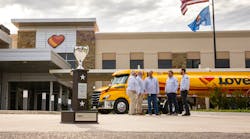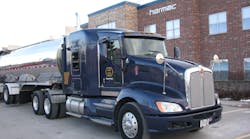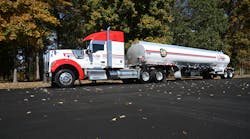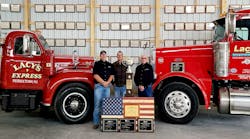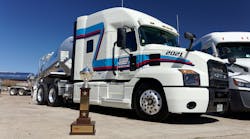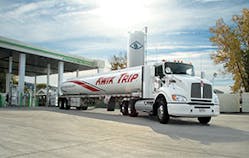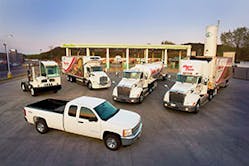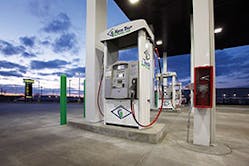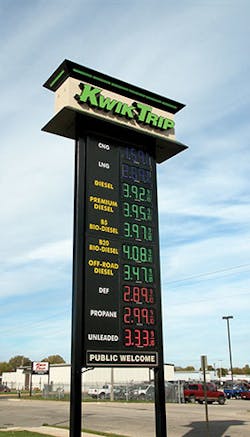SOME companies lead, while many others are content to follow. La Crosse, Wisconsin-based Kwik Trip Stores Inc certainly has been a leader when it comes to demonstrating the benefits of natural gas as a truck fuel for petroleum hauling and food distribution fleets.
Natural gas fueled trucks and tractors currently make up about 30% of the Kwik Trip distribution fleet, and the company trucks and tractors will be fully on natural gas within the next two years. On the petroleum distribution side, the company runs 60 tractors (20 of them fueled by natural gas) and 60 petroleum tank trailers. The company also leases one liquefied natural gas (LNG) trailer.
The petroleum fleet serves more than 410 convenience store locations in four midwestern states—Wisconsin, Minnesota, Iowa, and Illinois. Natural gas is now part of the fuel mix at 25 of the c-stores. Vehicle fueling options at the company’s stores include gasoline, E85, diesel, biodiesel, propane, and electrical charging stations.
Kwik Tripp c-stores also sell a multitude of groceries and other products, and that side of the business is supported by a fleet of 25 refrigerated straight trucks, 55 tractors, and roughly 100 refrigerated trailers.
“We’re true believers in making LNG and CNG (compressed natural gas) go from alternative fuel to a standard fuel,” says Chad Hollett, Kwik Trip director of transportation and distribution. “We are adding CNG dispensers at more of our c-stores, and we will also supply LNG at locations along strategic interstate corridors.
“We are able to show customers and fleets that they can fuel with confidence and move forward with the purchase of CNG and LNG vehicles. Not a day goes by that we don’t get 50 to 100 calls to learn about our plans for natural gas. Customers want to know when it will be available in their area.”
Joel Hirschboeck, Kwik Trip commercial fuels superintendent, adds that the company’s move to natural gas vehicle fuel was years in the making. “We observed what was happening around the world, and we found that natural gas makes a lot of sense,” he says. “The shale gas developments in the United States made natural gas even more attractive due to the positive price point. Natural gas also offers huge benefits from the environmental standpoint.”
From the very beginning, the Kwik Trip management team saw natural gas as a fuel for both its own fleet and for the broader marketplace, according to Hirschboeck. “Natural gas is a fit for many applications,” he says. “We have focused on CNG at most of our locations because that is what the market says it wants, but we will also distribute LNG where it makes sense. We’re focused on building out our natural gas infrastructure. We have several CNG fueling sites under construction now, and we will add eight more in 2014. Our natural gas dispensers are under canopy with the other fuel options we offer. With CNG delivered at 3,600 psi, our driver-friendly dispensers can fill a truck fuel tank in just 10 to 12 minutes.”
Hirschboeck says he is becoming increasingly optimistic about the future of natural gas as a truck fuel. “We see more fleets adding more natural gas-fueled trucks, sometimes getting a push from shippers,” he says. “It’s hard to say whether there has been much displacement of diesel, but we know some fleets are in the process of transitioning from diesel-fueled trucks to natural gas. We’ve seen improvements in equipment and pricing. The (Cummins Westport) ISX12 G is working well and did better than some diesel engines during the extreme cold (lows of –30°F, for instance) of this past winter.”
Three units
Running under the Convenience Transportation LLC name, the distribution fleet is divided into three units. The Petroleum Department keeps 130 drivers busy hauling refined fuels to Kwik Trip stores and outside accounts. The Fresh Delivery Department has 30 drivers and is responsible for delivering all fresh bakery products and glazers and all cooler totes containing sandwiches, fruits, vegetables, and frozen pizzas. Eighty drivers in the Grocery Department deliver virtually all of the merchandise sold at the company’s c-stores and tobacco outlets.
Kwik Trip keeps its petroleum delivery fleet running virtually around the clock, seven days a week. Most of the tractors are slip-seated for maximum productivity, and each vehicle typically has four assigned drivers. The company employs 150 drivers.
Petroleum transports are dispersed among 19 locations, usually near petroleum terminals. Depending on the length of each trip, a driver will haul three to six loads during a 12-hour shift.
Every effort is made to haul maximum loads, and split loads are typical. “We want a full trailer for each shipment,” Hirschboeck says. “Remote tank monitoring at our c-stores enables our six petroleum dispatchers to schedule on-time shipments of the specific products that are needed.”
The Kwik Trip fleet hauls 90% to 95% of the fuel sold through its c-stores. In 2014, that will add up to roughly 125,000 loads equaling about a billion gallons.
High mileages
Fleet vehicles average 200,000 miles a year keeping the 410 Kwik Trip stores supplied. That adds up to a hefty fuel bill every month, but the natural gas-fueled trucks are helping to trim the fuel costs. Hirschboeck says the company is saving about $80,000 a year with its CNG-fueled trucks.
“CNG sells for about $1.79.9 a gallon now at a majority of our stores,” Hirschboeck says. “We chose CNG for our distribution fleet, because the infrastructure is already in place in many areas. However, CNG and LNG both have a place in the market.”
Currently, 35 of the Kwik Trip trucks run on natural gas, and 20 of them are tractors. The numbers have grown rapidly since the company bought its first CNG-fueled trucks in 2012. Another 35 medium- and heavy-duty CNG fueled trucks are scheduled for delivery during the winter. Kwik Trip also has begun buying CNG-fueled pickup trucks.
Kwik Trip page 2...
The company runs a very diverse fleet that includes Kenworth, Freightliner, Peterbilt, Volvo, and Mack trucks. “We wanted to try all of the OEMs’ (original equipment manufacturers’) products to see how they perform with natural gas,” Hirschboeck says. “We want to gain as much knowledge as we can.”
The fleet’s first CNG-fueled trucks were specified with the 8.9-liter Cummins Westport ISL G engine rated for 320 horsepower. The trucks had Allison 3000 automatic transmissions. The terrain in the Kwik Trip operating area is relatively flat, and the trucks have performed well. Fuel economy has been in the six-mile-per-gallon range based on diesel equivalent.
“All of the trucks in our most recent orders were specified with the new 12-liter ISX12 G,” Hirschboeck says. “Horsepower ratings are 350 to 400. The first trucks we ordered with the 12-liter engine had Eaton 10-speed manual transmissions, but the latest order has the Allison 4000 automatic.
“The higher horsepower is important because we are running relatively heavy loads. Our tractor-trailer rigs gross out at 80,000 pounds.”
Trucks and tractors have dual 90-diesel-gallon-equivalent fuel tanks. On the newest vehicles, the fuel tanks are covered by a fairing that is more aesthetically pleasing.
All of the new tractors are spec’d for fuel hauling with a 6x2 drive configuration for cost savings and less weight. Components include air disc brakes all around, roll stability, Michelin widebase tires, tire pressure monitoring, and a Holland aluminum fifthwheel.
Petroleum trailers are supplied by Heil Trailer and Polar Tank Trailer Inc. The newest units can carry 9,500 gallons. Tank hardware includes Civacon bottom loading systems, overfill protection, vapor recovery, and domelids. Newer tank trailers were specified with Hendrickson Intraax suspensions with tire pressure monitoring.
Maintenance department
Fleet maintenance is handled in-house by 19 technicians at the company’s 20,350-sq-ft maintenance shop at the La Crosse location. Technicians are trained to repair and maintain refrigerated trailers, petroleum tankers, tractors, light- and medium-duty trucks, and automobiles.
Special maintenance systems for the petroleum distribution fleet includes two dedicated bays at the La Crosse maintenance complete with elaborate fall protection. An adjustable ramp and railing system helps ensure that mechanics can work safely on the tops of tank trailers.
Mechanics have been trained to perform minor and major repairs to CNG and LNG engines and fuel systems. The shop met virtually all of the natural gas requirements in the National Fire Protection Association’s 32A and 52 guidelines.
The company spent $45,000 to isolate one shop bay for LNG vehicle service. An extra air-handling system was installed along with a methane detection instrument.
Mechanics have received training on engine maintenance through Cummins Westport, and they have been instructed on fuel tank installations by Agility Fuel Systems.
Preparation procedures for engine and fuel system service include pulling the truck into the shop, closing the CNG valve on the truck, and running the engine to burn off fuel in the line. The purging process takes about 30 seconds.
When more detailed work is required, mechanics can use defueling ports on the fuel tanks to completely remove all of the CNG in the tank. The fuel tank can then be charged with nitrogen to eliminate any chance of fire.
The maintenance program helps ensure that the fleet is kept in top shape enabling
efficient and timely delivery of groceries and other food products to
the Kwik Trip stores. ♦


